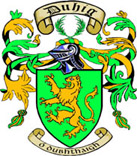
This unusual and interesting name is of Irish origin, and is a variant of the name (O')Duffy, itself widespread in Ireland. Duhig arose, as did the other variants, Doohey and Dowey, from local pronunciations of the Irish
The original spelling of the surname was "O' Dubhthaigh", a surname in which the root word is "dubh" the old Celtic Irish word for "black". It is thought that the name 'O' Dubhthaigh related to the black haired tribes in 523 AD who supported the then King of Munster "Aenghus"
In its present form this surname is found mainly in South Munster, but there are several distinct septs of O'Duffy. Some members of these septs were remarkable for their contribution to the Church, the most noteworthy being Cele O'Duffy, Archbishop of Tuam, who was King Roderick O'Connors ambassador to Henry 11 in 1175. Another noteworthy namebearer was Father Eugene O' Duffy (circa 1527 - 1615), along with Sir James Duhig who was born at Limerick in 1871 and was Archbishop of Brisbane, Australia for forty-six years. a famous preacher who always used the Irish language in his sermons.
The first recorded spelling of the family name is shown to be that of Muiredagh Duhig, Archbishop of Tuam, County Galway, in 1075 , during the reign of High Kings of Ireland with opposition, 1022 - 1166. It was King Toirdelbach Ua Briain who first presented the Duhig family with its Coat of Arms in 1075, and it was at this time that the name was shortened to the spelling we now have today.
Surnames became necessary when governments introduced personal taxation. In England this was known as Poll Tax. Throughout the centuries, surnames in every country have continued to "develop" often leading to astonishing variants of the original spelling.
(septs = the Gaelic word for surname)
If you visit http://myrootsmagic.com/TerryDuhig/index.html you will find more information about the Duhig family history
My line of the DUHIG clan, is as a result of the Duhig and Corcoran families joining together when my parents married
The item below is about a member of the Corcoran side of my family

The person in this photo is my Great Grandfather Patrick Corcoran, who was born on the 17 August 1883 and died 19 September 1961.
Patrick was born in Clonmel, Tipperary, Ireland.
At the age of 17 Patrick joined the armed forces, in fact his service record shows that Patrick enlisted on 6th November 1900 at Woking Surrey England and was attached to the 2nd Battalion Royal Irish Regiment.
At the start of WW1 on 28 July 1914, The Royal Irish Regiment was part of The British Expeditionary Force 3rd Division 8th Brigade.
Between August 1914 and February 1915, Patrick was in action in the Battle of Mons in Belgium, where he was mentioned in public dispatches and received a citation from King George.
In 1916 Patrick was wounded and taken prisoner by the Germans, in the August of that year the Red Cross were able to take the wounded solders and officers of ALL NATIONS to one of their hospitals in Switzerland, where they were interned until the end of the war.
Following repatriation to England at the end of the war, Patrick was declared as medically unfit for military duties due to injuries sustained in two wars (The Anglo-Aro war 1901 in the Battle of Edimma January 1902 and in WW1 The Battle of the Somme in July 1916) on 16 December 1919 and was returned to his regiment at their home barracks in Inniskilling, where he was discharged from military service on 13 March 1920.
Patrick Corcoran received various medals for his service including the Victory Medal, the 1914 Star and Clasp with Roses.